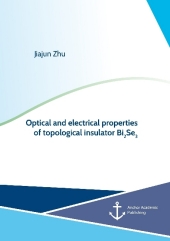 Neuerscheinungen 2017Stand: 2020-02-01 |
Schnellsuche
ISBN/Stichwort/Autor
|
Herderstraße 10
10625 Berlin
Tel.: 030 315 714 16
Fax 030 315 714 14
info@buchspektrum.de |

Jiajun Zhu
Optical and electrical properties of topological insulator Bi2Se3
2017. 112 S. 58 Abb. 270 mm
Verlag/Jahr: ANCHOR ACADEMIC PUBLISHING 2017
ISBN: 3-9606716-0-1 (3960671601)
Neue ISBN: 978-3-9606716-0-2 (9783960671602)
Preis und Lieferzeit: Bitte klicken
Topological insulator is one of the hottest research topics in solid state physics. This is the first book to describe the vibrational spectroscopies and electrical transport of topological insulator Bi2Se3, one of the most exciting areas of research in condensed matter physics. In particular, attempts have been made to summarize and develop the various theories and new experimental techniques developed over years from the studies of Raman scattering, infrared spectroscopy and electrical transport of topological insulator Bi2Se3. It is intended for material and physics researchers and graduate students doing research in the field of optical and electrical properties of topological insulators, providing them the physical understanding and mathematical tools needed to engage research in this quickly growing field. Some key topics in the emerging field of topological insulators are introduced.
Text Sample:
Chapter 2.2 Substrate choice:
Topological insulators can be grew by chemical vapor deposition, bulk Bridgman growth, wet chemical synthesis, and molecular beam epitaxy (MBE). The MBE technique can keep accurate film thickness with very good doping control, and potential integration of heterostructures for device structures. The MBE growth of topological materials mechanism is different from that of conventional materials which require a strict lattice-matching. Van der Waals bonds between the QLs relax the lattice-matching condition. Therefore, many substrates have been selected for the growth of topological materials [...].
During the growth, reflection high energy electron diffraction (RHEED) is commonly used. The distance between the two first-order stripes are the d-spacing. It is inversely proportional to the lattice constant. The lattice is nearly fully relaxed to the topological films, which can be known from the d-spacing reaching a constant value.
2.3 Doping effect:
2.3.1 Ca doping to control Fermi level:
The bulk carrier density of topological insulators is relatively high due to the defects. This suppresses the surface states conduction. The most commonly observed defects in Bi2Se3 are the vacancy of Se atoms. In order to lower the bulk carrier density as well as to control the Fermi level into the bulk bandgap, counter doping method is widely used. Ca is a p-type dopant and it replaces Bi in Bi2Se3. [...].
As a widely studied topological insulator, it is difficult to achieve low bulk conductivity for Bi2Se3, which depend on the Se partial pressure in synthesis. Although Bi2Te3 can be made n or p type through variation in the Bi:Te ratio, reported transport studies of Bi2Se3 shows p-type behavior. Native Bi2Se3 is usually n-type due to Se vacancies, which act as electron donors. The chemical properties of Bi and Te are similar, which leads to antisite defects as the primary source of carrier doping in binary compounds. However, tendency for Bi and Se mixing in Bi2Se3 is little. The main structural defect leading to electron doping is doubly charged Se vacancies Compensation doping is a common way to counteract the presence of Se vacancies. It requires careful control over p-type dopant concentrations, but it will result high bulk conductivity. The use of Ca substitution for Bi creates a negatively charged defect, which generates holes to compensate the electrons created by the Se vacancies. This is particular important as Sharma et al. demonstrated that ion implantation is a useful way for the p-type doing of Bi2Se3 with a precise control over the number and spatial distribution of dopants. Ion beam modification has two advantages compared with other approaches. First of all, it enables further control over carrier concentration to achieve low bulk conductivity. Secondly, it is efficient to fabricate inhomogeneous planar device structures. After ion implantation, the structure of material is usually damaged but such issue can be solved by a low temperature annealing. In order to mitigate ion beam damage and prevent Se loss during annealing, a thin layer of Al2O3 is coated. Calcium ion implantation broadens peak in X-ray diffraction and proper annealing process reduces the peak broadening. The annealing temperature is 350 °C, which is far below the melting temperature 700 °C. Therefore, recrystallization does not happen. It reflects that annealing removes ion beam damage. [...].
Note that Calcium is the simplest p-type dopant in Bi2Se3. The p-type behavior was reported to be induced through low-level substitutions (1% or less) of Ca for Bi. Fermi level is lowered into the valence band by about 400 meV in 2% Ca doped Bi2Se3 compared to the n-type material. Moreover, nanoclusters of CaSe are found in Ca doped Bi2Se3 films. The interface between insulator CaSe and topological insulator Bi2Se3 is topological nontrivial interface state.


